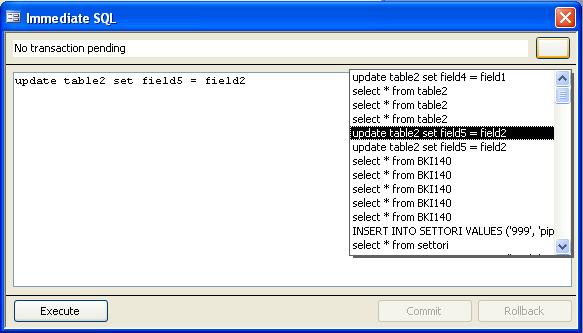
Introduction
This project is an Access 2003 add-in written in VBA. It allows users to write and to execute subsequent DML SQL statements with transaction control. This tool is useful when you want to modify data using SQL queries that affect multiple records in multiple tables.
At the end, after a careful check, you can commit the entire transaction. Modifications in Microsoft Access records are committed by moving across fields or rows and, very often, rollback is impossible. This add-in avoids this behavior. The users can also have a preview of the affected changes over multiple tables before committing the work.
Background
Often, modification queries do not produce intended results. In this case, if the user doesn't have a backup copy of the database, you could have serious problems trying to recreate the initial state. I have crreated an MDA Access add-in which permits the writing of SQL statements (SELECT, INSERT, UPDATE, DELETE) and their execution within a transaction, which can be committed or discarded.
Using the code
This Addin is self-registering. To use it, you simply have to:
- copy the .mda file in the Microsoft ACCESS directory where msaccess.exe is located
- open Microsoft Access 2003 or above
- go to Tools->Add-ins->Add-in Manager
- browse for the .mda file
- click OK
You can view the loaded add-in "ImmediateSQL" under the Tools->Add-ins menu. You can browse and change the source code using the internal VBA Macro Editor. At the top of the main window, as shown in the above figure, there is a label indicating the transaction state. At the top-right, there is a button that shows the last 15 statements executed. You can recall them by clicking on them.
You can write DML statements (SELECT, INSERT, UPDATE, DELETE) and execute them by clicking on the "Execute" button or by pressing F5. The transaction begins at the first execution. To see the transaction in action, you have to modify your table with a massive update query and execute a "select *" statement to view record changes. Then you can compare with the original table opened from the tables panel in the database window.
The changes are invisible in the original table or to other users until you have committed the transaction after using the DB. It works with all kind of tables, including connected ODBC, and the transaction also works across multiple databases.
Points of interest
The view management is very simple. It is interesting code that executes statements:
Private Sub ExecuteStatement()
If IsNull(Me.txtStmt.Value) Or Trim(Me.txtStmt.Value) = "" Then
MsgBox "No statement to execute", vbExclamation
Exit Sub
End If
If Not isInTransaction Then
Conn.BeginTrans
isInTransaction = True
End If
Dim cmd As ADODB.Command
Set cmd = New ADODB.Command
Set cmd.ActiveConnection = c
cmd.CommandText = Me.txtStmt.Value
On Error GoTo Errore
Dim r As ADODB.Recordset
Set r = cmd.Execute(recno)
On Error GoTo 0
If r.State <> adStateClosed Then
r.Close
r.LockType = adLockOptimistic
r.CursorLocation = adUseClient
r.Open
OpenTempTable r
Else
MsgBox "processed rows:" & recno
End If
InsertIntoStatements Me.txtStmt.Value
UpdateDisplay
Exit Sub
Errore:
MsgBox "Error:" & Err.Number & vbCrLf & Err.Description, vbCritical
UpdateDisplay
End Sub
The connection is set when the window is loaded. Then the statement is executed with an ADODB.Command. The Transaction is managed through ADODB.Connection. If the statement returns a recordset, then the results are displayed by calling the OpenTempTable subroutine. The statement executed is registered into an internal table "_Statements" by calling the InsertIntoStatements subroutine.
The OpenTempTable subroutine is interesting because it uses some internal Access functions to create a temp form. The sub adds as many textboxes as fields in the recordset and then binds them to the transacted recordset. At the end, the records are shown as a datasheet to seem like a true Access table:
Private Sub OpenTempTable(r As ADODB.Recordset)
Dim frm As Form
Dim frmname As String
frmname = "_tmpForm"
On Error Resume Next
DoCmd.Close acForm, frmname
DoCmd.DeleteObject acForm, frmname
On Error GoTo 0
DoCmd.CopyObject , "_tmpForm", acForm, "Form2"
DoCmd.OpenForm frmname, acDesign, , , , acHidden
For Each f In r.Fields
With CreateControl(frmname, acTextBox)
.Name = f.Name
.Properties("ControlSource") = f.Name
End With
Next
DoCmd.OpenForm frmname, acFormDS
Set Forms(frmname).Recordset = r
Forms(frmname).Refresh
DoCmd.Save acForm, frmname
End Sub
InsertIntoStatements subroutine shows how to access add-in hidden tables through CodeProject.AccessConnection rather than CurrentProject.Connection or CurrentProject.AccessConnection. Firstly, the subroutine checks if the statement is different from the last statement executed. If it is different, you have to insert the statement in an internal table. Then, if there are more than 15 statements, you have to delete the older one:
Private Sub InsertIntoStatements(stmt As String)
Dim r As ADODB.Recordset
Set r = New ADODB.Recordset
r.Open "SELECT count(1) AS cntr FROM _Statements WHERE date = _
(SELECT MAX(DATE) FROM _Statements) AND STATEMENT = """ & stmt _
& """", CodeProject.AccessConnection
If r!cntr > 0 Then
Exit Sub
End If
r.Close
Dim cmd As ADODB.Command
Set cmd = New ADODB.Command
cmd.CommandText = "INSERT INTO _Statements VALUES _
(Now(), """ & _stmt & """ )"
cmd.ActiveConnection = CodeProject.AccessConnection
cmd.Execute
r.Open "SELECT count(1) AS cntr FROM _Statements", _
CodeProject.AccessConnection
If r!cntr > 15 Then
cmd.CommandText = "DELETE FROM _Statements WHERE date = _
(SELECT MIN(date) FROM _Statements)"
cmd.ActiveConnection = CodeProject.AccessConnection
cmd.Execute
End If
Me.List9.Requery
End Sub
I think this tool could be evolved in order to create and automate Database scripts to upgrade, clean or move data.
History
- 12 April, 2007 - Original version posted
- 23 May, 2007 - First article update
